DODGE SPRINTER 2007 2.G Owners Manual
Manufacturer: DODGE, Model Year: 2007, Model line: SPRINTER, Model: DODGE SPRINTER 2007 2.GPages: 393, PDF Size: 7.61 MB
Page 131 of 393
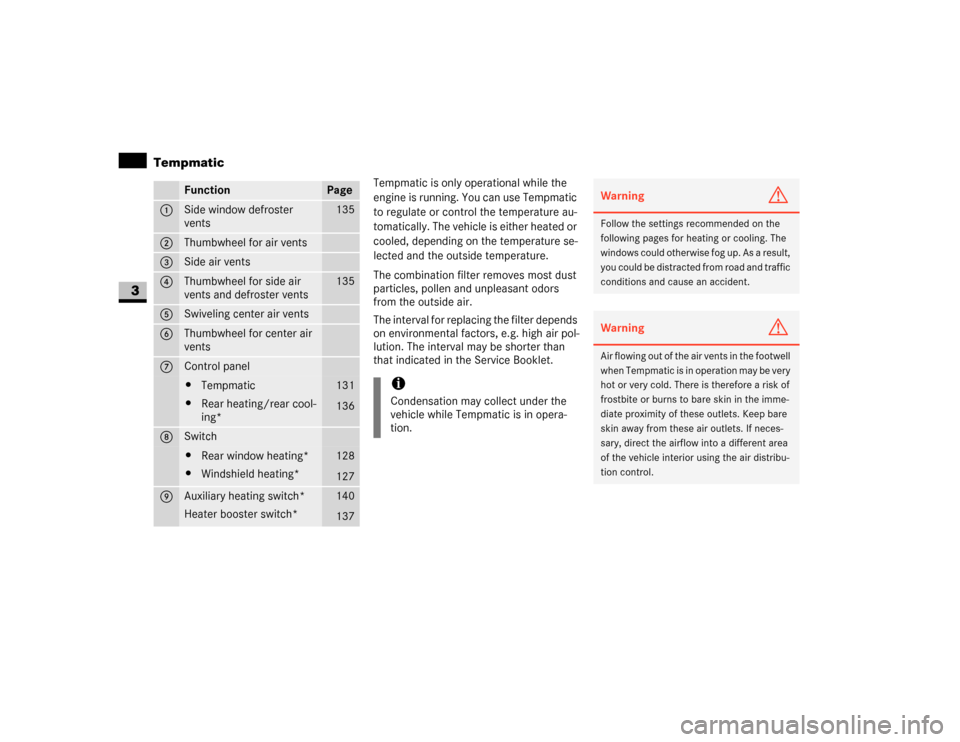
130 Controls in detailTempmatic
3
Tempmatic is only operational while the
engine is running. You can use Tempmatic
to regulate or control the temperature au-
tomatically. The vehicle is either heated or
cooled, depending on the temperature se-
lected and the outside temperature.
The combination filter removes most dust
particles, pollen and unpleasant odors
from the outside air.
The interval for replacing the filter depends
on environmental factors, e.g. high air pol-
lution. The interval may be shorter than
that indicated in the Service Booklet.
Function
Page
1
Side window defroster
vents
135
2
Thumbwheel for air vents
3
Side air vents
4
Thumbwheel for side air
vents and defroster vents
135
5
Swiveling center air vents
6
Thumbwheel for center air
vents
7
Control panel\4Tempmatic
\4Rear heating/rear cool-
ing*
131
136
8
Switch\4Rear window heating*
\4Windshield heating*
128
127
9
Auxiliary heating switch*
Heater booster switch*
140
137
iCondensation may collect under the
vehicle while Tempmatic is in opera-
tion.
Warning
G
Follow the settings recommended on the
following pages for heating or cooling. The
windows could otherwise fog up. As a result,
you could be distracted from road and traffic
conditions and cause an accident.Warning
G
Air flowing out of the air vents in the footwell
when Tempmatic is in operation may be very
hot or very cold. There is therefore a risk of
frostbite or burns to bare skin in the imme-
diate proximity of these outlets. Keep bare
skin away from these air outlets. If neces-
sary, direct the airflow into a different area
of the vehicle interior using the air distribu-
tion control.
Page 132 of 393
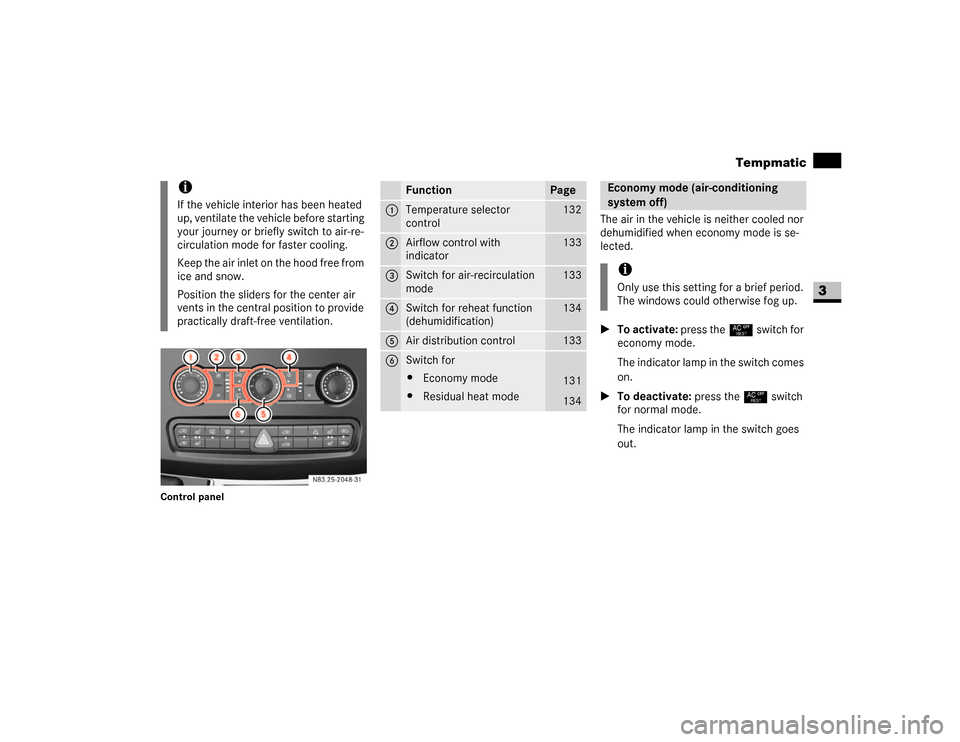
131 Controls in detail
Tempmatic
3
Control panel
The air in the vehicle is neither cooled nor
dehumidified when economy mode is se-
lected.
\1To activate: press the° switch for
economy mode.
The indicator lamp in the switch comes
on.
\1To deactivate: press the° switch
for normal mode.
The indicator lamp in the switch goes
out.
iIf the vehicle interior has been heated
up, ventilate the vehicle before starting
your journey or briefly switch to air-re-
circulation mode for faster cooling.
Keep the air inlet on the hood free from
ice and snow.
Position the sliders for the center air
vents in the central position to provide
practically draft-free ventilation.
N83.25-2048-31
Function
Page
1
Temperature selector
control
132
2
Airflow control with
indicator
133
3
Switch for air-recirculation
mode
133
4
Switch for reheat function
(dehumidification)
134
5
Air distribution control
133
6
Switch for
\4Economy mode
\4Residual heat mode
131
134
Economy mode (air-conditioning
system off)iOnly use this setting for a brief period.
The windows could otherwise fog up.
Page 133 of 393
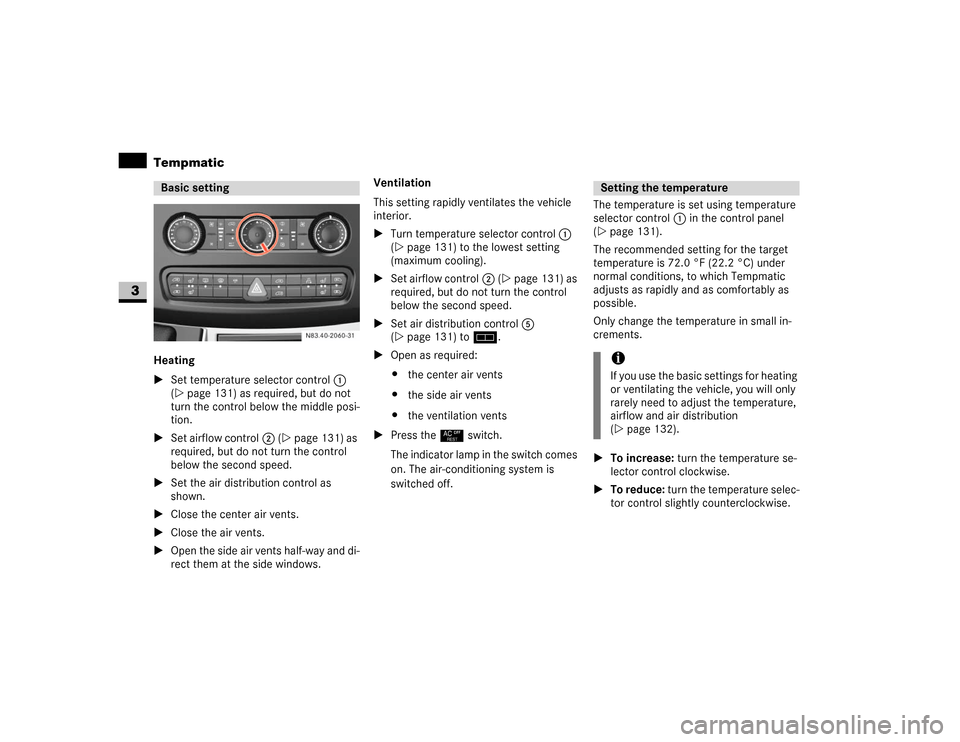
132 Controls in detailTempmatic
3
Heating
\1Set temperature selector control 1
(\2page 131) as required, but do not
turn the control below the middle posi-
tion.
\1Set airflow control2 (\2page 131) as
required, but do not turn the control
below the second speed.
\1Set the air distribution control as
shown.
\1Close the center air vents.
\1Close the air vents.
\1Open the side air vents half-way and di-
rect them at the side windows.Ventilation
This setting rapidly ventilates the vehicle
interior.
\1Turn temperature selector control 1
(\2page 131) to the lowest setting
(maximum cooling).
\1Set airflow control2 (\2page 131) as
required, but do not turn the control
below the second speed.
\1Set air distribution control5
(\2page 131) to h.
\1Open as required:
\4the center air vents
\4the side air vents
\4the ventilation vents
\1Press the° switch.
The indicator lamp in the switch comes
on. The air-conditioning system is
switched off.The temperature is set using temperature
selector control1 in the control panel
(\2page 131).
The recommended setting for the target
temperature is 72.0 °F (22.2 °C) under
normal conditions, to which Tempmatic
adjusts as rapidly and as comfortably as
possible.
Only change the temperature in small in-
crements.
\1To increase: turn the temperature se-
lector control clockwise.
\1To reduce: turn the temperature selec-
tor control slightly counterclockwise.Basic setting
N83.40-2060-31
Setting the temperatureiIf you use the basic settings for heating
or ventilating the vehicle, you will only
rarely need to adjust the temperature,
airflow and air distribution
(\2page 132).
Page 134 of 393
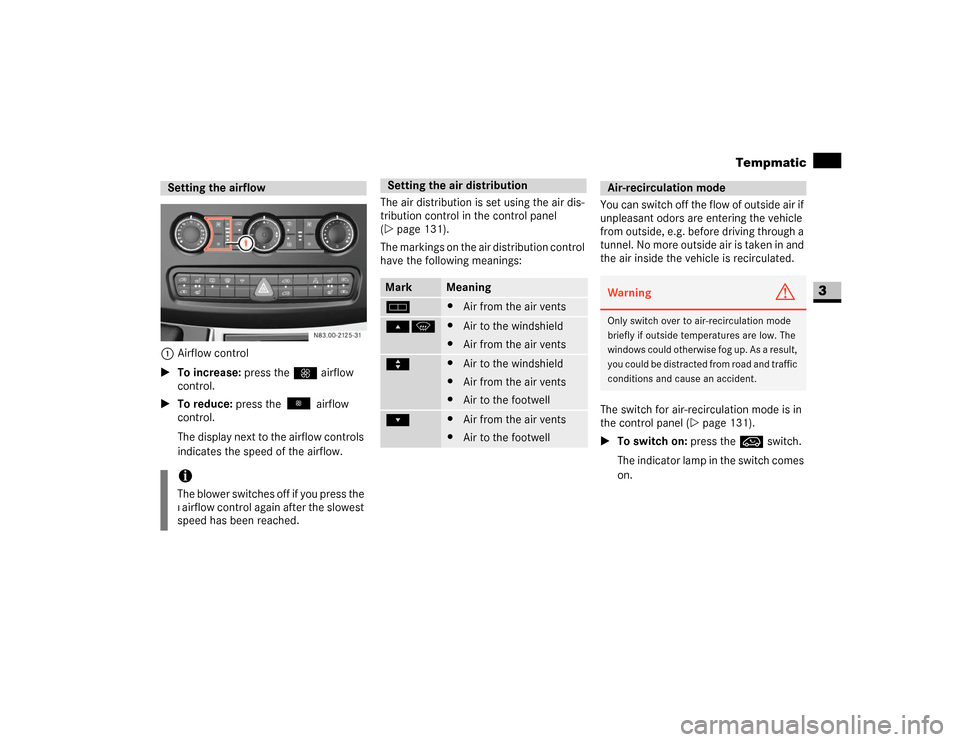
133 Controls in detail
Tempmatic
3
1Airflow control
\1To increase: press theQ airflow
control.
\1To reduce: press the airflow
control.
The display next to the airflow controls
indicates the speed of the airflow.The air distribution is set using the air dis-
tribution control in the control panel
(\2page 131).
The markings on the air distribution control
have the following meanings:You can switch off the flow of outside air if
unpleasant odors are entering the vehicle
from outside, e.g. before driving through a
tunnel. No more outside air is taken in and
the air inside the vehicle is recirculated.
The switch for air-recirculation mode is in
the control panel (\2page 131).
\1To switch on: press theÄ switch.
The indicator lamp in the switch comes
on.Setting the airflowiThe blower switches off if you press the
ß airflow control again after the slowest
speed has been reached.N83.00-2125-31
Setting the air distributionMark
Meaning
h
\4Air from the air vents
ÔP
\4Air to the windshield
\4Air from the air vents
Ò
\4Air to the windshield
\4Air from the air vents
\4Air to the footwell
Ó
\4Air from the air vents
\4Air to the footwell
Air-recirculation modeWarning
G
Only switch over to air-recirculation mode
briefly if outside temperatures are low. The
windows could otherwise fog up. As a result,
you could be distracted from road and traffic
conditions and cause an accident.
Page 135 of 393
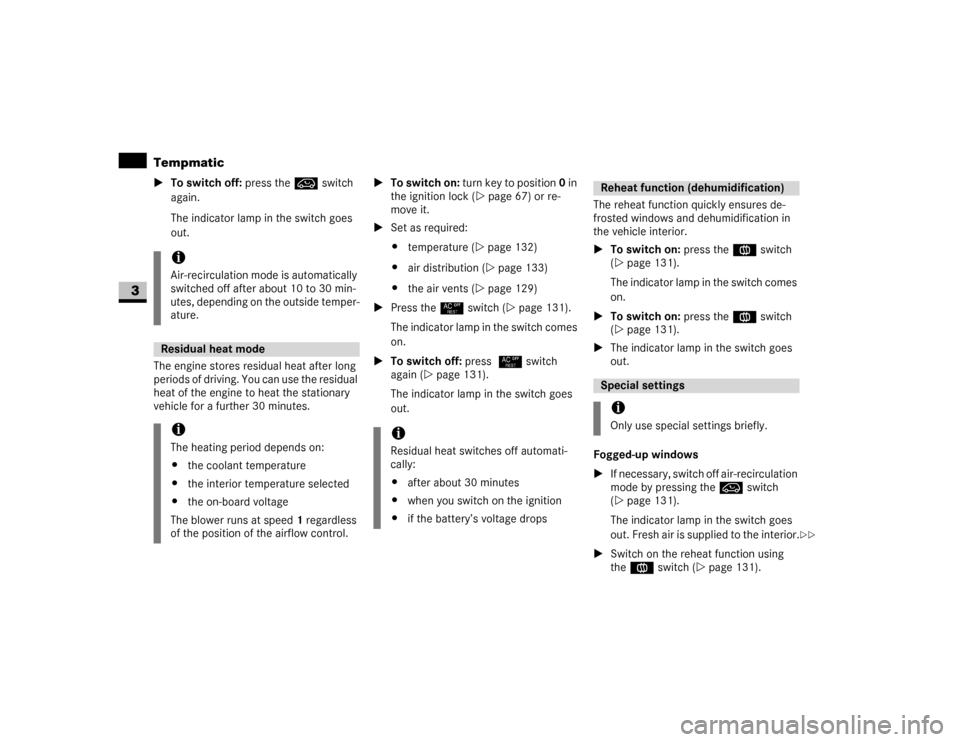
134 Controls in detailTempmatic
3
\1To switch off: press theÄ switch
again.
The indicator lamp in the switch goes
out.
The engine stores residual heat after long
periods of driving. You can use the residual
heat of the engine to heat the stationary
vehicle for a further 30 minutes.\1To switch on: turn key to position 0 in
the ignition lock (\2page 67) or re-
move it.
\1Set as required:
\4temperature (\2page 132)
\4air distribution (\2page 133)
\4the air vents (\2page 129)
\1Press the° switch (\2page 131).
The indicator lamp in the switch comes
on.
\1To switch off: press ° switch
again (\2page 131).
The indicator lamp in the switch goes
out.The reheat function quickly ensures de-
frosted windows and dehumidification in
the vehicle interior.
\1To switch on: press theÅ switch
(\2page 131).
The indicator lamp in the switch comes
on.
\1To switch on: press theÅ switch
(\2page 131).
\1The indicator lamp in the switch goes
out.
Fogged-up windows
\1If necessary, switch off air-recirculation
mode by pressing theÄ switch
(\2page 131).
The indicator lamp in the switch goes
out. Fresh air is supplied to the interior.
\1Switch on the reheat function using
theÅ switch (\2page 131).
iAir-recirculation mode is automatically
switched off after about 10 to 30 min-
utes, depending on the outside temper-
ature.Residual heat mode iThe heating period depends on:
\4the coolant temperature
\4the interior temperature selected
\4the on-board voltage
The blower runs at speed1 regardless
of the position of the airflow control.
iResidual heat switches off automati-
cally:
\4after about 30 minutes
\4when you switch on the ignition
\4if the battery’s voltage drops
Reheat function (dehumidification)Special settingsiOnly use special settings briefly.
\2\2
Page 136 of 393
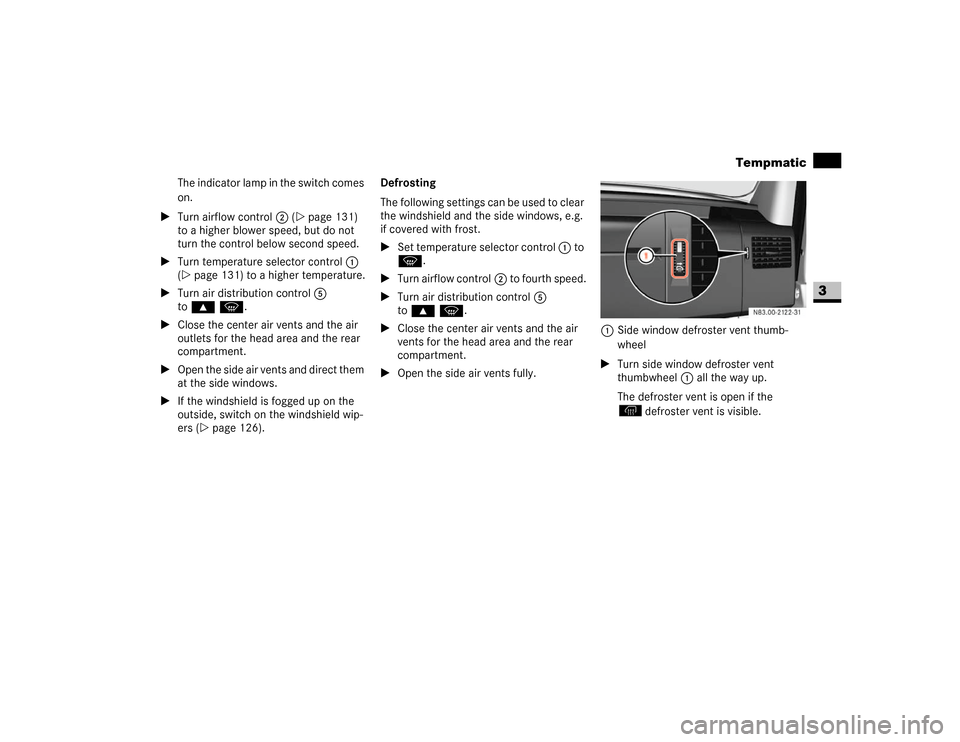
135 Controls in detail
Tempmatic
3
The indicator lamp in the switch comes
on.
\1Turn airflow control2 (\2page 131)
to a higher blower speed, but do not
turn the control below second speed.
\1Turn temperature selector control1
(\2page 131) to a higher temperature.
\1Turn air distribution control5
to‚P.
\1Close the center air vents and the air
outlets for the head area and the rear
compartment.
\1Open the side air vents and direct them
at the side windows.
\1If the windshield is fogged up on the
outside, switch on the windshield wip-
ers (\2page 126).Defrosting
The following settings can be used to clear
the windshield and the side windows, e.g.
if covered with frost.
\1Set temperature selector control 1 to
P.
\1Turn airflow control2 to fourth speed.
\1Turn air distribution control5
to‚P.
\1Close the center air vents and the air
vents for the head area and the rear
compartment.
\1Open the side air vents fully.1Side window defroster vent thumb-
wheel
\1Turn side window defroster vent
thumbwheel1 all the way up.
The defroster vent is open if the
defroster vent is visible.
Page 137 of 393
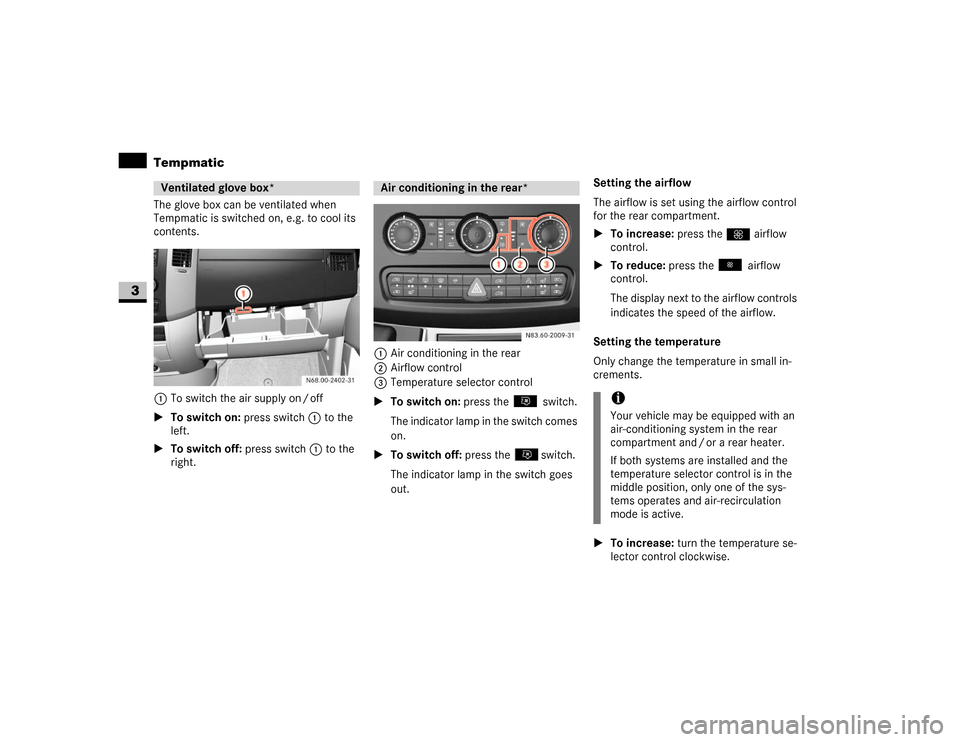
136 Controls in detailTempmatic
3
The glove box can be ventilated when
Tempmatic is switched on, e.g. to cool its
contents.
1To switch the air supply on / off
\1To switch on: press switch1 to the
left.
\1To switch off: press switch1 to the
right.1Air conditioning in the rear
2Airflow control
3Temperature selector control
\1To switch on: press the switch.
The indicator lamp in the switch comes
on.
\1To switch off: press the switch.
The indicator lamp in the switch goes
out.Setting the airflow
The airflow is set using the airflow control
for the rear compartment.
\1To increase: press theQ airflow
control.
\1To reduce: press the airflow
control.
The display next to the airflow controls
indicates the speed of the airflow.
Setting the temperature
Only change the temperature in small in-
crements.
\1To increase: turn the temperature se-
lector control clockwise.Ventilated glove box*
Air conditioning in the rear*
N83.60-2009-31
iYour vehicle may be equipped with an
air-conditioning system in the rear
compartment and / or a rear heater.
If both systems are installed and the
temperature selector control is in the
middle position, only one of the sys-
tems operates and air-recirculation
mode is active.
Page 138 of 393
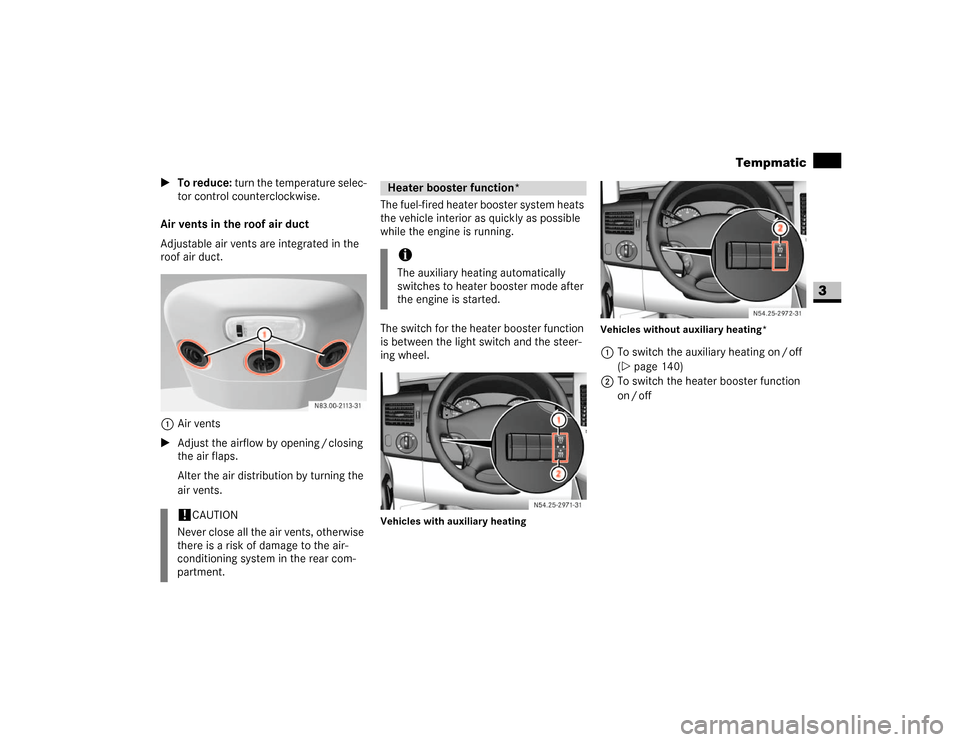
137 Controls in detail
Tempmatic
3
\1To reduce: turn the temperature selec-
tor control counterclockwise.
Air vents in the roof air duct
Adjustable air vents are integrated in the
roof air duct.
1Air vents
\1Adjust the airflow by opening / closing
the air flaps.
Alter the air distribution by turning the
air vents.The fuel-fired heater booster system heats
the vehicle interior as quickly as possible
while the engine is running.
The switch for the heater booster function
is between the light switch and the steer-
ing wheel.
Vehicles with auxiliary heatingVehicles without auxiliary heating*
1To switch the auxiliary heating on / off
(\2page 140)
2To switch the heater booster function
on / off
!
CAUTION
Never close all the air vents, otherwise
there is a risk of damage to the air-
conditioning system in the rear com-
partment.
Heater booster function*iThe auxiliary heating automatically
switches to heater booster mode after
the engine is started.
N54.25-2926-31
N54.25-2927-31
Page 139 of 393
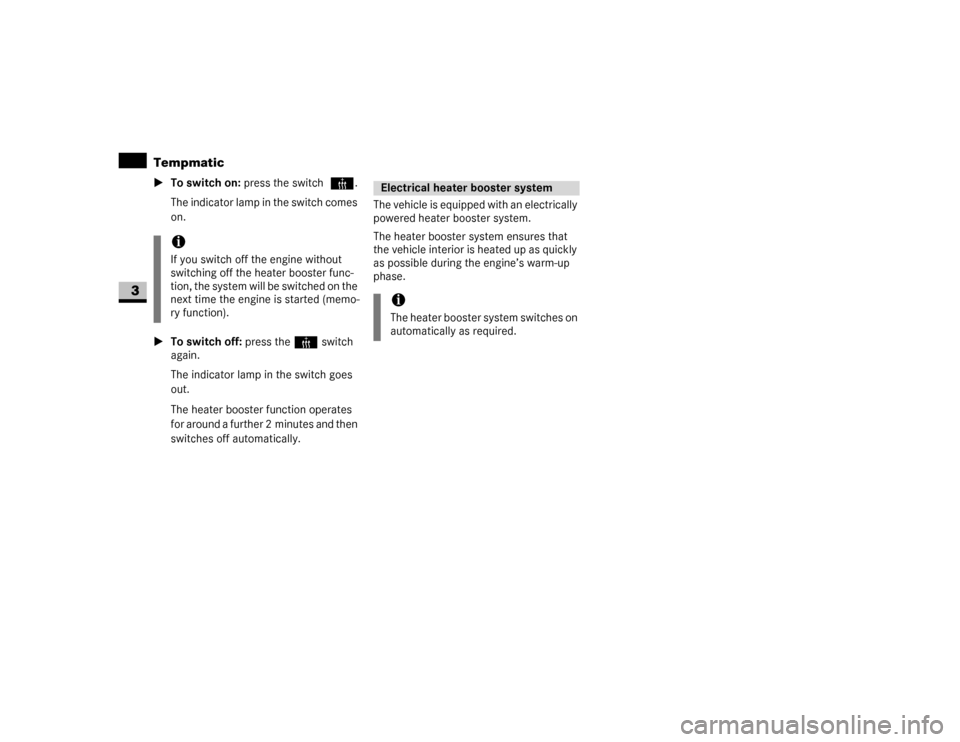
138 Controls in detailTempmatic
3
\1To switch on: press the switch³.
The indicator lamp in the switch comes
on.
\1To switch off: press the³ switch
again.
The indicator lamp in the switch goes
out.
The heater booster function operates
for around a further 2 minutes and then
switches off automatically.The vehicle is equipped with an electrically
powered heater booster system.
The heater booster system ensures that
the vehicle interior is heated up as quickly
as possible during the engine’s warm-up
phase.
iIf you switch off the engine without
switching off the heater booster func-
tion, the system will be switched on the
next time the engine is started (memo-
ry function).
Electrical heater booster systemiThe heater booster system switches on
automatically as required.
Page 140 of 393
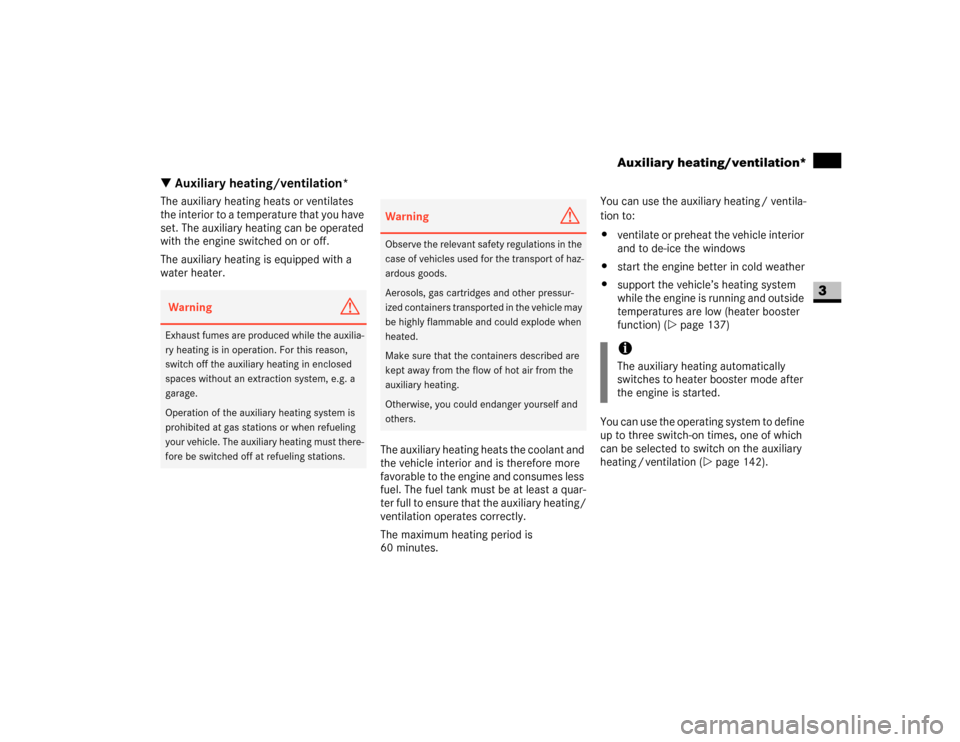
139 Controls in detail
Auxiliary heating/ventilation*
3
\3 Auxiliary heating/ventilation*The auxiliary heating heats or ventilates
the interior to a temperature that you have
set. The auxiliary heating can be operated
with the engine switched on or off.
The auxiliary heating is equipped with a
water heater.
The auxiliary heating heats the coolant and
the vehicle interior and is therefore more
favorable to the engine and consumes less
fuel. The fuel tank must be at least a quar-
ter full to ensure that the auxiliary heating/
ventilation operates correctly.
The maximum heating period is
60 minutes.You can use the auxiliary heating / ventila-
tion to:
\4ventilate or preheat the vehicle interior
and to de-ice the windows
\4start the engine better in cold weather
\4support the vehicle’s heating system
while the engine is running and outside
temperatures are low (heater booster
function) (\2page 137)
You can use the operating system to define
up to three switch-on times, one of which
can be selected to switch on the auxiliary
heating / ventilation (\2page 142). Warning
G
Exhaust fumes are produced while the auxilia-
ry heating is in operation. For this reason,
switch off the auxiliary heating in enclosed
spaces without an extraction system, e.g. a
garage.
Operation of the auxiliary heating system is
prohibited at gas stations or when refueling
your vehicle. The auxiliary heating must there-
fore be switched off at refueling stations.
Warning
G
Observe the relevant safety regulations in the
case of vehicles used for the transport of haz-
ardous goods.
Aerosols, gas cartridges and other pressur-
ized containers transported in the vehicle may
be highly flammable and could explode when
heated.
Make sure that the containers described are
kept away from the flow of hot air from the
auxiliary heating.
Otherwise, you could endanger yourself and
others.
iThe auxiliary heating automatically
switches to heater booster mode after
the engine is started.